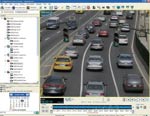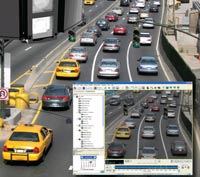
Innovation Meets Integration
Integrating CCTV with other security systems across IP networks offers significant benefits
- By Barry Keepence
- Jan 04, 2010
 Integrating two or more security systems across an IP network provides the end user with far greater benefits than individual systems. Add this to the long list of advantages a distributed IP video system delivers, and the end result is a very compelling argument for integration.
Integrating two or more security systems across an IP network provides the end user with far greater benefits than individual systems. Add this to the long list of advantages a distributed IP video system delivers, and the end result is a very compelling argument for integration.
The ability to pass alarms and events between each system across the network is the key to the power of integration. An alarm in one system can trigger a number of events in another. For example, an illegal entry alarm can cause the nearest PTZ CCTV camera to pan to a pre-defined position and stream video of the entrance to a spot monitor, and an interactive map can display the position of the alarm and send an e-mail notification. This provides an efficient operator environment that significantly improves incident response.
A Unified Operator Environment
Ideally, manufacturers would deliver a single solution that provided the integration of all aspects of security—CCTV, access control, intruder and perimeter protection, and automatic number plate recognition. However, such systems don't exist. Even if they did, it would be difficult for the complete solution to have the same features and capabilities of individual systems that are developed by companies that specialize in one particular area. End users don't mind that their integrated solution is provided by different suppliers, as long as one PC can control the entire system. They want one application to display and acknowledge the alarms from all sources.
The security system most used by operators is CCTV. It is logical to consolidate all alarms in the IP video system. This also means that the video can be bookmarked by alarms and events from the other systems, allowing advanced searching of the video using these events. This gives the operator a visual record of any alarm or event in the system—a powerful tool for incident management, auditing and evidence gathering.
Electronic Point of Sale
The logic of integrating security systems together is evident; however, if information from systems such as EPOS can be interfaced, then a powerful security solution for applications in the retail market and casinos can be deployed.
Data sent from an EPOS system can be overlaid on a live video display, allowing operators to view the camera feed and till transaction simultaneously. The transaction information and alarms generated by the EPOS system can be bookmarked and recorded alongside the video. This facilitates visual identification of an incident in real time and through post-event analysis.
Powerful transaction analysis can be undertaken on the stored data; for example, finding out when a particular credit card was used by searching every till in a store or across all stores from the head office. Conversely, recorded video can be searched using a thumbnail feature, which displays a video still image for every transaction, allowing the operator to quickly identify the relevant footage. Evidential quality video clips and associated transaction data can be exported for investigation or use in court.
Alarms generated by the EPOS system, such as "register drawer left open," "refund" or "large dollar amount," can automatically trigger a number of events, including displaying the nearest camera to the specific till and pinpointing the alarm on an interactive map.
Alarms from non-security systems, such as building management and plant monitoring, also can easily be integrated into the system and benefit retail applications; for example, alerting staff when a freezer fails or a door is left open. These types of discreet signals can be interfaced to the network using input/ output functions on hardware such as video transmitters or by using dedicated IP alarm panels.
Integrating Raw Video
The integration of alarm and event data between systems is quite straightforward, allowing a number of powerful causes and effects to be implemented. However, IP video manufacturers are now making available interfaces to their raw video, through software development kits. This opens up a number of new applications that can be integrated over the IP network, including LPR, face recognition, advanced analytics processing, video fire/smoke detection and video walls. LPR is an excellent example of how this type of integration can work.
LPR is a mature and established technology that is used in homeland security, traffic and parking management and, more recently, with toll roads. However, it is typically used in stand-alone solutions that provide users with a simple list of license plates that have been recognized by specific cameras. The video produced by LPR cameras is only useful for the recognition software and not for general surveillance. By integrating LPR with CCTV, the application can be further enhanced:
- The actual license plate number can be overlaid with the video from adjacent CCTV cameras, thereby giving a visual confirmation of the occupants and vehicle make.
- The plate number can be bookmarked with the video, making it very easy to search for the appropriate clip in the future.
- When a vehicle is identified from the watch list, an alarm can be raised in the CCTV system, alerting operators and automatically displaying cameras relevant to the location of the vehicle.
Distributing LPR
Typically, LPR systems work by connecting a small number of specialized analog LPR cameras directly to an LPR server, a number of which can be networked together. Unlike leading IP video systems, this is not a truly distributed architecture. Cameras still have to be hardwired directly to the server.
The high levels of computing power required for license plate recognition means that only a small number of cameras can be connected to a single LPR server, causing cabling problems and the need for more servers if the cameras are widely dispersed.
Integrating the LPR on the same network as the IP-CCTV system allows it to be completely distributed. As with any CCTV camera, LPR cameras can be positioned at any point on the network and at any distance from the LPR server, as the video is carried by the network and not dedicated coax cabling. As the LPR servers are networked together, they act in the same way as a stand-alone system, providing the same functionality and connection to external interfaces such as national police databases and ticketing systems.
When an LPR system is integrated with an IP video solution, it uses the same video format, with LPR cameras connected to the network via video transmitters. The LPR server then reads the streamed video from the network in much the same way as a CCTV video management workstation. This means that the LPR system can use video from standard CCTV cameras located anywhere on the network. In this situation, the recognition success rate will typically be lower than when using LPR cameras; however, given good environmental conditions, using standard cameras is possible and provides a cost-effective solution for less critical applications.
With the reduction in cabling from sharing the IP video network and the possibility of using standard CCTV cameras, the installation costs of an LPR system, when integrated with IP video, can lead to savings in addition to the significant operational benefits.
High-Definition Video
With the advent of HD IP cameras with low data rates and advanced H.264 compression, high-definition video can be streamed across standard networks and recorded using mainstream storage solutions. This is an important factor as applications such as LPR and face recognition often require the high-quality images delivered by HD cameras.
Storing core alarm and event data from many different security systems with CCTV video is a compelling argument for integration, providing an excellent solution for analysis, auditing and evidence gathering. Triggering cause and effect actions from this data leads to improved operator efficiency and incident response, providing possible savings from reduced security staff.
Extending integration to sharing raw video leads to better use of specialist systems such as LPR. IP video manufacturers that provide this level of integration will be able to offer end users a powerful solution to manage all of their security needs.
This article originally appeared in the issue of .